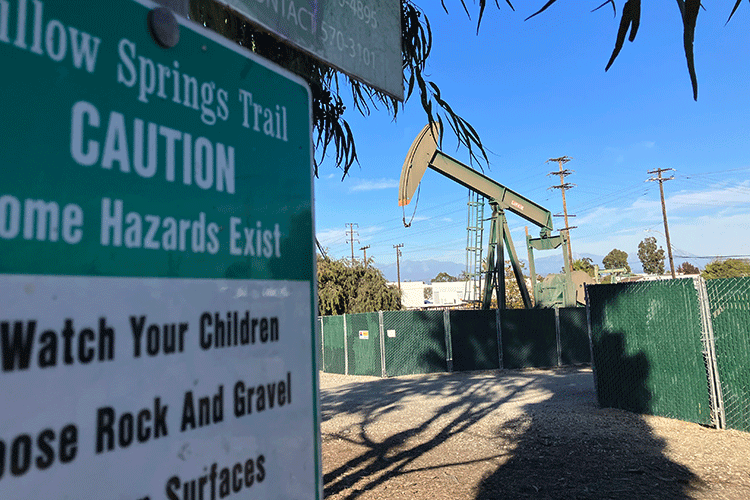Black, Latinx Californians Face Highest Exposure to Oil and Gas Wells

A Spanish version of this article is available here.
More than 1 million Californians live near active oil or gas wells, potentially exposing them to drilling-related pollution that can contribute to asthma, preterm births and a variety of other health problems.
A new study appearing today in the journal GeoHealth finds that these Californians are disproportionately Black, Latinx or low-income.
“When we look across the state of California over the past 15 years, Black, Latinx and low-income people consistently were more likely to live near oil and gas wells,” said study first author David González, a President’s Postdoctoral Fellow at the University of California, Berkeley. “Black people, in particular, were more likely to be in places that had the most intensive oil and gas production, which can lead to more exposure to harmful chemicals.”
The study also found that while oil and gas production in California has declined over the past 15 years, the rate of decrease has been slower near racially marginalized communities. Earlier work led by González found that disparities in exposure to oil and gas wells can be traced back to the 1930s in Los Angeles and linked to the historical policy of redlining.
“What’s emerging is that oil and gas wells have been disproportionately impacting racially marginalized and low-income communities in California for generations,” González said. “We found that redlining was strongly associated with the disproportionate siting of oil and gas wells in historically racially marginalized communities, and we’re still seeing disproportionate siting and production of oil and gas infrastructure in many of these same neighborhoods today.”
Oil and gas production is a complex process that can release an array of hazardous pollutants: Drilling rigs and other heavy machinery emit diesel exhaust, active wells can release toxic volatile organic compounds, and in some cases, the chemicals that are used to extract oil from underground reservoirs can seep into the water supply, endangering those who rely on groundwater for drinking. Operating heavy drilling machinery in residential areas can also create other stressors, like light and sound pollution.
Mounting evidence suggests that these pollutants pose a variety of health risks to those who live close to wells — that distance usually is defined as living within 1 kilometer (km), or a little over half a mile.
The California climate measures signed into law last September by Gov. Gavin Newsom contained provisions that would ban new drilling within approximately 1 km of homes, schools, hospitals and parks and provide protections for those living near existing wells. But in early February, oil companies succeeded in putting the law on hold until voters decide its fate in a November 2024 ballot referendum.
“The weight of scientific evidence clearly demonstrates that people living near oil and gas development have a greater risk of respiratory problems and adverse birth outcomes,” said Seth B.C. Shonkoff, executive director of PSE Healthy Energy and an associate researcher at UC Berkeley’s School of Public Health. “Attempts to undermine or delay California’s landmark setback law contradict the science and increase public health risks, particularly for Black and brown communities.”
Given the complexity of oil and gas operations, many studies only consider proximity to wells when investigating the health risks of oil and gas production. However, this focus on proximity may mask additional disparities in the hazards posed by more intensive production, the researchers said.
The current study, which found that Black Californians are more likely to be exposed to more intensive oil productions, might help explain why some studies have found that the health risks associated with living near wells are higher for racially and socioeconomically marginalized people.
Rachel Morello-Frosch, professor at UC Berkeley’s School of Public Health and in the Department of Environmental Science, Policy and Management and the study’s senior author, said she hopes the paper makes clear the health equity implications of the oil and gas industry in California.
“This study advances scientific understanding about the origins and persistence of racialized inequities in exposure to oil and gas extraction in California, which in turn has significant implications for regulatory interventions that center environmental justice in protecting community health from this well-documented environmental hazard,” Morello-Frosch said.
In addition to the 1 million Californians who live near active or retired wells, nearly 9 million — 20% of the population — live close to wells that have been plugged and abandoned, some as early as the 1800s. While wells that have been plugged in recent years are held to rigorous environmental standards, other studies have found that some of these older wells may still be emitting toxic chemicals that could be harmful to those living nearby.
“The most common exposure to oil and gas infrastructure in California was to plugged and abandoned wells,” González said. “From a public health perspective, it’s not clear how worried we should be about plugged wells. But given how many people live near them, I think it’s important to ask more questions and take care when we retire wells so we don’t create problems down the road.”
Additional study co-authors include Claire M. Morton of Stanford University; Lee Ann L. Hill, Drew R. Michanowicz and Robert J. Rossi of PSE Healthy Energy; and Joan A. Casey of the University of Washington. This study was supported by the California Air Resources Board (#18RD018) and National Institute of Environmental Health Sciences (R00 ES027023).
RELATED INFORMATION
- Temporal Trends of Racial and Socioeconomic Disparities in Population Exposures to Upstream Oil and Gas Development in California (GeoHealth)
- More oil and gas wells in redlined neighborhoods
- Living near oil and gas wells tied to low birth weights in infants
- A Spanish translation of this article is available here.
